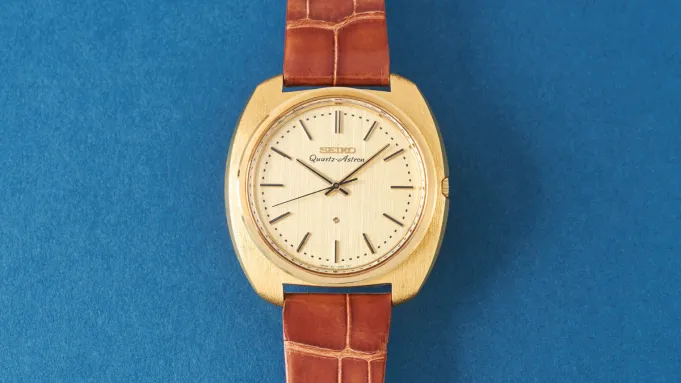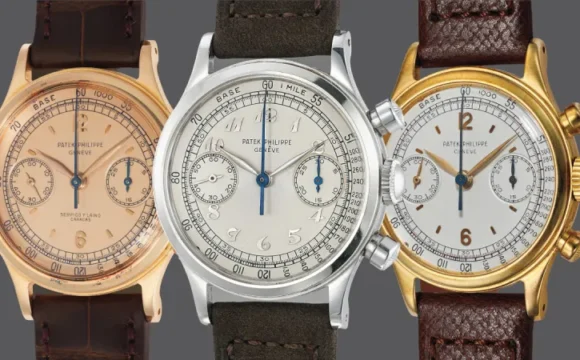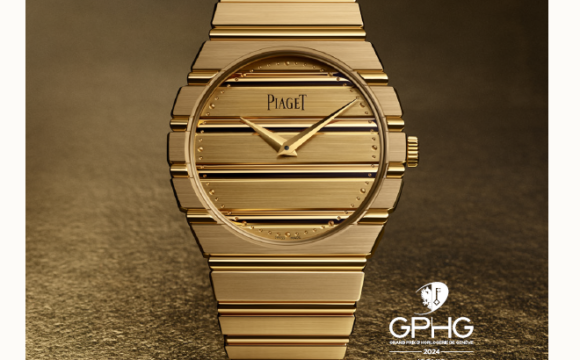ดาวเด่นของพิพิธภัณฑ์อาจเป็น 1969 35SQ Quartz Astron ซึ่งเป็นนาฬิกาข้อมือควอตซ์เชิงพาณิชย์เรือนแรกของโลก เปิดตัวอย่างยิ่งใหญ่ในวันคริสต์มาสที่ย่านกินซ่า โตเกียว ก่อนสิ้นทศวรรษ นาฬิกาเรือนนี้เป็นจุดเริ่มต้นของการปฏิวัติวงการนาฬิกา ทำให้การบอกเวลาที่แม่นยำเข้าถึงผู้คนได้มากขึ้น แต่ในขณะเดียวกันก็ส่งผลกระทบต่ออุตสาหกรรมนาฬิกาเครื่องกล
นาฬิกาเรือนนี้สวยงาด้วยตัวเรือนทองคำ 18 กะรัตแบบฟลอเรนไทน์ ขาและหน้าปัดทองคำ นาฬิกาเหล่านี้มีราคาแพงอย่างเหลือเชื่อในขณะนั้น ผลิตขึ้นหลายร้อยเรือนและขายในราคา 450,000 เยน ซึ่งคาดว่าจะแพงกว่า Toyota Corolla ในช่วงนั้น! Quartz Astron แตกต่างจากนาฬิกาควอตซ์ราคาถูกที่ในที่สุดก็จะท่วมตลาดเมื่อเทคโนโลยีถูกทำให้เชี่ยวชาญสำหรับการผลิตจำนวนมาก
Seiko หันไปหา Grand Seiko เพื่อหาแรงบันดาลใจสำหรับตัวเรือนของ Astron ตัวเรือนที่คล้ายกันนี้ถูกใช้สำหรับ Grand Seiko Astronomical Observatory Chronometers (AOC) ที่ผลิตในเวลาเดียวกัน ทั้งสองเป็นสัญลักษณ์และการเฉลิมฉลองการจับเวลาที่แม่นยำ หนึ่งเครื่องจักรอีกเครื่องหนึ่งอิเล็กทรอนิกส์ แต่ในขณะที่ AOC แบบกลไกมีความแม่นยำสองวินาทีต่อวัน Quartz Astron มีความแม่นยำห้าวินาทีต่อเดือน
ก่อนที่จะออกจากรุ่นกลางศตวรรษอย่างสมบูรณ์ Grand Seiko 56GS ปี 1971 ในทองคำ 18 กะรัตก็คุ้มค่าแก่การตรวจสอบ ที่นี่คุณจะพบแรงบันดาลใจสำหรับ Grand Seiko SBGA211 “snowflake" dial สมัยใหม่ แต่คราวนี้ทำจากทองคำแท้
จากบทความโดย David Flett
The star of the show as far as the museum is concerned is probably the 1969 35SQ Quartz Astron—the world’s first commercially available quartz wristwatch. Famously launched on Christmas Day in Tokyo’s Ginza district a week before the end of the decade, it was to fundamentally change the industry, being the first step on a journey that would democratize precise timekeeping for the masses, but ultimately lead to the decimation of the mechanical watchmaking industry.
The watch is stunning, with its solid 18-karat gold case with a Florentine finish, gold hands and gold dial. These watches were phenomenally expensive at the time. Several hundred were made and sold at a price of 450,000 yen, supposedly more than a Toyota Corolla at the time! The Quartz Astron was far removed from the cheap quartz watches that would eventually flood the market once the technology was mastered for mass production.
Seiko turned to Grand Seiko for the inspiration for the case of the Astron. A very similar case had been used for the Grand Seiko Astronomical Observatory Chronometers (AOC) being produced at the same time. Both were symbols and celebrations of precision timekeeping, one mechanical the other electronic, but while the mechanical AOC was precise to two seconds per day, the Quartz Astron was precise to five seconds per month.
Before leaving the mid-century models completely, the 1971 Grand Seiko 56GS in 18-karat gold is worth examining. Here you will find the inspiration for the modern Grand Seiko SBGA211 “snowflake" dial, but this time rendered in solid gold.
From the article by David Flett








